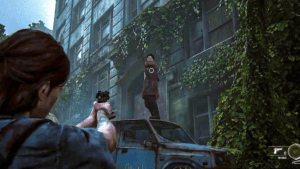


As a feminist traversing through “The Last of Us Part II,” it was fascinating to witness Ellie’s journey unfold in the post-apocalyptic world. It allowed me to delve into a complex intersection of gender, queerness, and intersectional feminism through a lens of gritty realism that video games often overlook.
Before reading “Playing like a Feminist”, I questioned what percentage of the demographic of video game players were women. After doing some searching, I found that a staggering 40-45% of the user base identified themselves as women which was a staggering amount. While I had been a gamer myself, indulging in First-person shooter and Team Tactical games, I only felt the presence of a heterosexual toxic man. Playing Last of Us of Ellie’s segment was refreshing as I had rarely played a female character in a video game let alone dug deep into the narrative.
The types of fun experienced in the game are Aesthetics of Challenge, Fantasy, Discovery and Sensation. The game uses third-person action-adventure mechanics combined with stealth and resource management, pushing the player to make strategic decisions. Ellie has a diverse range of abilities, from hand-to-hand combat to crafting various survival tools, further empowering her character and drawing the player into her journey. The game offers an immersive experience in a meticulously crafted world, filled with rich storylines, complex characters, and heart-racing action sequences. The emotional rollercoaster, intertwined with the thrill of survival, provides a unique blend of excitement and engagement for the player. The fun is crafted through a combination of well-written characters, intense gameplay, and a profound storyline that forces players to confront the consequences of their actions. The game also features several environmental puzzles that further challenge the player and add a layer of intellectual stimulation to the experience.
Historically, the video game industry has catered to male audiences, constructing a problematic connection between games and masculinity.” Yet “The Last of Us Part II” disrupts this narrative. Ellie, unlike the oversexualized women protagonists such as Lara Croft or Bayonetta, is presented as a determined and resourceful character. She embodies a more nuanced depiction of femininity, a significant departure from the conventional hyper-feminized female characters in games.
Ellie’s character shines a spotlight on the identity politics within the game’s narrative. Jennifer Malkowski and TreaAndrea Russworm suggest treating representation in video game studies as “a formative, not merely expressive,” system. Indeed, Ellie’s journey resonates with this notion as her queer identity is depicted not as a defining trait but as an intrinsic part of her character. Her relationship with Dina normalises queer love and reflects the multifaceted nature of identity in games.
Despite the notable progress in representation, “The Last of Us Part II” does fall short in intersectional feminism. There’s a visible lack of diverse characters, with most of the focus on Ellie and Dina, both white. While it is necessary to diversify gender representation, the author argues in “Play like a Feminist” that it is also a feminist concern to diversify racial representation.
It’s essential to address the inherent violence in the game. The historical bias towards masculinity in games often leans towards violent gameplay, and “The Last of Us Part II” is no exception. However, violence is portrayed as a necessity for survival, not a glorification of brutality or an element to empower female characters. Still, it opens a conversation about how the game could explore alternate forms of conflict resolution while retaining its depth and complexity.
Playing “The Last of Us Part II” illuminates the need to disrupt the “good old boys’ playground” and foster a more inclusive gaming culture, free from toxic masculinity. Ellie’s narrative challenges the traditional norms of the industry and offers a fresh perspective on femininity, queerness, and emotional labour.
The Proteus Effect, coined by Stanford Associate Professor Jeremy Bailenson, offers an intriguing perspective on player-character empathy. It posits that embodying a character in a virtual world can alter our attitudes and behaviours in reality. For instance, male players of “The Last of Us Part II” stepping into the shoes of Ellie, a queer female protagonist, could foster real-world empathy towards similar struggles faced by queer women.
This concept ties in seamlessly with our earlier dissection of game mechanics, themes, and fun elements. The game’s strategic choice of a female lead amplifies its feminist themes, inviting players to navigate a world they might not know, thus challenging preconceived notions and enhancing empathy.
This game, although imperfect, is a testament to how games can act as a conduit for feminist discourse, pushing the medium’s boundaries. It makes strides in terms of gender and queer representation but falls short in racial representation. However, the game’s success in inciting thoughtful engagement with issues of gender and queerness proves the invaluable role of feminist perspectives in diversifying and enriching the gaming landscape.


